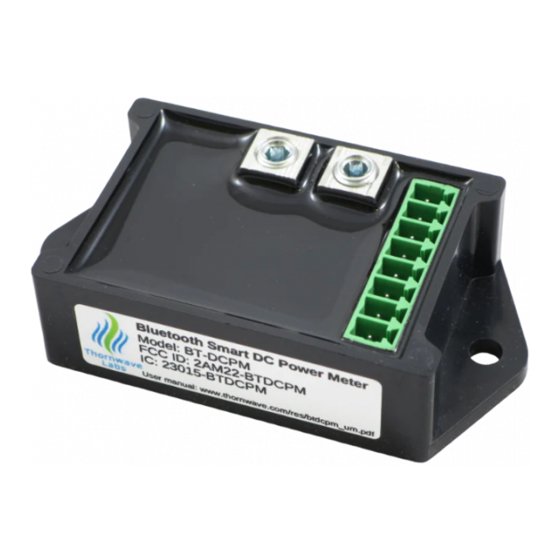Summary of Contents for Thornwave Labs PowerMon
- Page 1 PowerMon Bluetooth LE Advanced Battery Monitor / DC Power Meter – QUICKSTART GUIDE –...
- Page 2 This document is meant to be a quick start guide for installing and configuring the PowerMon, Bluetooth Battery Monitor / DC Power Meter and does not contain in-depth details. For a complete manual please visit the product webpage at https://www.thornwave.com Package contents.
-
Page 3: Safety Instructions
Read all the instructions and cautions before using the PowerMon device. Thornwave Labs Inc does not assume responsibility for any injury or property damage caused by improper installation, bad wiring or use of PowerMon outside of its intended purpose. The device should be installed by a professional. - Page 4 TERMINAL DESCRIPTION / INTERNAL DIAGRAM Name Terminal Description GROUND System ground Multi-function (for hardware revision 2.20 and up). Supports pushbutton input or external temperature sensor Relay output. It drives a mechanical or solid-state relay. This terminal RELAY is connected to ground internally by the device when the power is turned ON from the app.
-
Page 5: Mounting The Device
(walls, big metal objects) will interfere with it. • If an external shunt is used, mount it as close as possible to the PowerMon device. The longer the wires that connect the external shunt to the device the more electrical noise they will pick Wiring using the internal shunt (optional) •... - Page 6 Choose blue or yellow, or any color different than black or red. • If the Thornwave Labs SSR is used, connect RELAY (terminal 3) to the control terminal of the SSR Check all the connections again. Verify that the high current wires are tight. Use fuses or circuit breakers where applicable.
-
Page 7: Mobile Application
RSSI indicator and position the mobile device very close to the PowerMon you would like to identify. The RSSI will indicate a much stronger signal for that device. RSSI values are negative. -30dBm is a stronger signal than -60dBm. -
Page 8: Troubleshooting
• The phone Location Services is disabled, or the app does not have permission to access the Location Services. • The user tried to pair the PowerMon device as if it were a classic Bluetooth device. If this is the case, un-pair the PowerMon and use the app. - Page 9 “Bidirectional”, and the value immediately higher than the rated shunt voltage drop. For example for a 75mV shunt, choose +/- 80mV. The Shunt resistance has to be calculated based on the shunt used. • Resistance(mOhm) = Voltage(mV) divided by current(A) • The 500A shunts sold by Thornwave Labs are 0.15mOhms in value.








Need help?
Do you have a question about the PowerMon and is the answer not in the manual?
Questions and answers